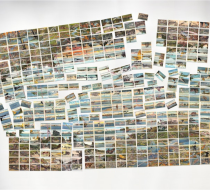Transforming Memory into Action: The Climate Crisis Through Vintage Visions Favorite
David Opdyke’s wry, panoramic visions of an America perceptibly in the grips of climate crisis were born of an artistic crisis—of “needing to come up an idea by digging somewhere other than my own brain.” Having drawn on his imagination to conjure up the trenchant, ecologically-inflected critiques of American imperialism and late-stage capitalism that have defined his work for twenty years, he wondered what more he might, artistically speaking, say.
This search for inspiration led Opdyke to his current medium: vintage postcards, carefully overlaid with hand-painted interventions, which he compiles into breathtaking, large-scale murals. In Opdyke’s hands, these postcards are transformed from snapshots of early twentieth-century leisure into emissaries from different futures—visions of spectacular manifestations of climate crisis.
Someday, all this is Opdyke’s second postcard mural and the subject of an exhibition by the Climate Museum’s pop-up space in SoHo, an expansive and detailed work that rewards deep attention and continued visits. Comprised of some four hundred-odd postcards drawn from the first three decades of the twentieth century, Opdyke’s mural takes the tranquil and triumphant images of a land leveled and tamed according to the gospel of development and clarifies the conditions that made the originals possible through his masterful interventions. It shows the extractive and colonizing logic underlying visions of progress run amok, making a lie of man’s mastery over nature. Skyscrapers, that symbol of late industrial modernity, are swarmed by fire or, worse still, by mutant caterpillars. Crows and monarch butterflies, grown monstrously large, emit their swansong. And humans, deservedly puny, are left clinging to stale and asinine catchphrases. Banners declaring that “political action would be immature” sit alongside signs reading “cut them loose,” or “we are better off without them.” Others allude to the presence of climate refugees. One slogan, “get saved! The ark!” earmarks an iteration of the biblical ark turned climate bunker as a source of salvation that portends the end of life as we know it.
Extreme weather events like wildfires, hurricanes, and tornadoes have become a part of our daily lives and news cycles, making it increasingly difficult to escape the reality that we are all living through climate crisis (and, at times, catastrophe). The question pieces like Opdyke’s inevitably raise is: what might art do?
This is where the Climate Museum and its curatorial philosophy enter the conversation, using Opdyke’s doctored postcards as the material for collective, political intervention. An activist museum with a slate of interdisciplinary programming, the Climate Museum takes the series of interventions (or “arguments,” as Opdyke calls them) staged by Someday, all this and works them into a launchpad for encouraging collective action on climate change. The museum uses art and culture to provoke a paradigm shift about individual and collective agency, a small yet consequential move given that many of us feel overwhelmed by the various manifestations of climate crisis. This is done with a relatively light touch by framing the exhibition not through Opdyke’s artistic practice (which is intricate and fascinating in its own right) but through a study published earlier this year in the academic journal Nature Communications that details the unspoken and bipartisan consensus among American adults about climate change and emphasizes the dissonance between this reality and the political status quo.
The Climate Museum effectively uses Opdyke’s mural as a throughline designed to drive audience engagement and, yes, action. Individual postcards drawn from Someday, all this are reprinted and available for visitors to send to members of Congress, which the museum mails on their behalf, or to friends and family. It might be said that the effect of a good exhibition is to spark conversations. The combined forces of Opdyke’s intricate and cerebral artistry, and the Climate Museum’s organizational potency has an adjacent effect: it sparks a culture of conversation about climate change. A visit to Someday, all this is characterized by conversations—with staff, docents, and other visitors— and invites a level of public engagement that mirrors the cultural and political action both the artist and museum seek to spur.
Can art transform us socially, politically, and culturally? Can it equip us to confront a crisis whose stakes are, frankly, existential? In Someday, all this visitors experience something unique: the confluence of an artist, a work, and a cultural institution determined to try.







